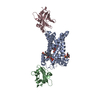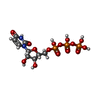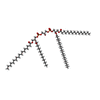[English] 日本語
 Yorodumi
Yorodumi- EMDB-50894: Proton conductance by human uncoupling protein 1 is inhibited by ... -
+ Open data
Open data
- Basic information
Basic information
| Entry |  | ||||||||||||
|---|---|---|---|---|---|---|---|---|---|---|---|---|---|
| Title | Proton conductance by human uncoupling protein 1 is inhibited by both purine and pyrimidine nucleotides | ||||||||||||
 Map data Map data | |||||||||||||
 Sample Sample |
| ||||||||||||
 Keywords Keywords | TRANSPORT PROTEIN | ||||||||||||
| Function / homology |  Function and homology information Function and homology informationpurine ribonucleotide binding / cellular response to dehydroepiandrosterone / Mitochondrial Uncoupling / The fatty acid cycling model / oxidative phosphorylation uncoupler activity / mitochondrial transmembrane transport / adaptive thermogenesis / cardiolipin binding / cellular response to fatty acid / regulation of reactive oxygen species biosynthetic process ...purine ribonucleotide binding / cellular response to dehydroepiandrosterone / Mitochondrial Uncoupling / The fatty acid cycling model / oxidative phosphorylation uncoupler activity / mitochondrial transmembrane transport / adaptive thermogenesis / cardiolipin binding / cellular response to fatty acid / regulation of reactive oxygen species biosynthetic process / long-chain fatty acid binding / response to temperature stimulus / cellular response to cold / diet induced thermogenesis / proton transmembrane transporter activity / transmembrane transporter activity / brown fat cell differentiation / cellular response to hormone stimulus / Transcriptional regulation of brown and beige adipocyte differentiation by EBF2 / proton transmembrane transport / response to cold / cellular response to reactive oxygen species / response to nutrient levels / GDP binding / positive regulation of cold-induced thermogenesis / mitochondrial inner membrane / regulation of transcription by RNA polymerase II / GTP binding / mitochondrion Similarity search - Function | ||||||||||||
| Biological species |  Homo sapiens (human) / Homo sapiens (human) /  | ||||||||||||
| Method | single particle reconstruction / cryo EM / Resolution: 3.03 Å | ||||||||||||
 Authors Authors | Jones SA / Sowton AP / Lacabanne D / King MS / Palmer SM / Zogg T / Pardon E / Steyaert J / Ruprecht JJ / Kunji ERS | ||||||||||||
| Funding support |  United Kingdom, European Union, United Kingdom, European Union,  Belgium, 3 items Belgium, 3 items
| ||||||||||||
 Citation Citation |  Journal: EMBO J / Year: 2025 Journal: EMBO J / Year: 2025Title: Proton conductance by human uncoupling protein 1 is inhibited by purine and pyrimidine nucleotides. Authors: Scott A Jones / Alice P Sowton / Denis Lacabanne / Martin S King / Shane M Palmer / Thomas Zögg / Els Pardon / Jan Steyaert / Jonathan J Ruprecht / Edmund R S Kunji /   Abstract: Uncoupling protein 1 (UCP1, SLC25A7) is responsible for the thermogenic properties of brown adipose tissue. Upon fatty acid activation, UCP1 facilitates proton leakage, dissipating the mitochondrial ...Uncoupling protein 1 (UCP1, SLC25A7) is responsible for the thermogenic properties of brown adipose tissue. Upon fatty acid activation, UCP1 facilitates proton leakage, dissipating the mitochondrial proton motive force to release energy as heat. Purine nucleotides are considered to be the only inhibitors of UCP1 activity, binding to its central cavity to lock UCP1 in a proton-impermeable conformation. Here we show that pyrimidine nucleotides can also bind and inhibit its proton-conducting activity. All nucleotides bound in a pH-dependent manner, with the highest binding affinity observed for ATP, followed by dTTP, UTP, GTP and CTP. We also determined the structural basis of UTP binding to UCP1, showing that binding of purine and pyrimidine nucleotides follows the same molecular principles. We find that the closely related mitochondrial dicarboxylate carrier (SLC25A10) and oxoglutarate carrier (SLC25A11) have many cavity residues in common, but do not bind nucleotides. Thus, while UCP1 has evolved from dicarboxylate carriers, no selection for nucleobase specificity has occurred, highlighting the importance of the pH-dependent nucleotide binding mechanism mediated via the phosphate moieties. | ||||||||||||
| History |
|
- Structure visualization
Structure visualization
| Supplemental images |
|---|
- Downloads & links
Downloads & links
-EMDB archive
| Map data |  emd_50894.map.gz emd_50894.map.gz | 481.9 MB |  EMDB map data format EMDB map data format | |
|---|---|---|---|---|
| Header (meta data) |  emd-50894-v30.xml emd-50894-v30.xml emd-50894.xml emd-50894.xml | 24.4 KB 24.4 KB | Display Display |  EMDB header EMDB header |
| FSC (resolution estimation) |  emd_50894_fsc.xml emd_50894_fsc.xml | 19.2 KB | Display |  FSC data file FSC data file |
| Images |  emd_50894.png emd_50894.png | 35 KB | ||
| Filedesc metadata |  emd-50894.cif.gz emd-50894.cif.gz | 6.9 KB | ||
| Others |  emd_50894_half_map_1.map.gz emd_50894_half_map_1.map.gz emd_50894_half_map_2.map.gz emd_50894_half_map_2.map.gz | 475.6 MB 475.6 MB | ||
| Archive directory |  http://ftp.pdbj.org/pub/emdb/structures/EMD-50894 http://ftp.pdbj.org/pub/emdb/structures/EMD-50894 ftp://ftp.pdbj.org/pub/emdb/structures/EMD-50894 ftp://ftp.pdbj.org/pub/emdb/structures/EMD-50894 | HTTPS FTP |
-Validation report
| Summary document |  emd_50894_validation.pdf.gz emd_50894_validation.pdf.gz | 693.2 KB | Display |  EMDB validaton report EMDB validaton report |
|---|---|---|---|---|
| Full document |  emd_50894_full_validation.pdf.gz emd_50894_full_validation.pdf.gz | 692.8 KB | Display | |
| Data in XML |  emd_50894_validation.xml.gz emd_50894_validation.xml.gz | 25.7 KB | Display | |
| Data in CIF |  emd_50894_validation.cif.gz emd_50894_validation.cif.gz | 33.3 KB | Display | |
| Arichive directory |  https://ftp.pdbj.org/pub/emdb/validation_reports/EMD-50894 https://ftp.pdbj.org/pub/emdb/validation_reports/EMD-50894 ftp://ftp.pdbj.org/pub/emdb/validation_reports/EMD-50894 ftp://ftp.pdbj.org/pub/emdb/validation_reports/EMD-50894 | HTTPS FTP |
-Related structure data
| Related structure data |  9fzqMC M: atomic model generated by this map C: citing same article ( |
|---|---|
| Similar structure data | Similarity search - Function & homology  F&H Search F&H Search |
- Links
Links
| EMDB pages |  EMDB (EBI/PDBe) / EMDB (EBI/PDBe) /  EMDataResource EMDataResource |
|---|
- Map
Map
| File |  Download / File: emd_50894.map.gz / Format: CCP4 / Size: 512 MB / Type: IMAGE STORED AS FLOATING POINT NUMBER (4 BYTES) Download / File: emd_50894.map.gz / Format: CCP4 / Size: 512 MB / Type: IMAGE STORED AS FLOATING POINT NUMBER (4 BYTES) | ||||||||||||||||||||||||||||||||||||
|---|---|---|---|---|---|---|---|---|---|---|---|---|---|---|---|---|---|---|---|---|---|---|---|---|---|---|---|---|---|---|---|---|---|---|---|---|---|
| Projections & slices | Image control
Images are generated by Spider. | ||||||||||||||||||||||||||||||||||||
| Voxel size | X=Y=Z: 0.645 Å | ||||||||||||||||||||||||||||||||||||
| Density |
| ||||||||||||||||||||||||||||||||||||
| Symmetry | Space group: 1 | ||||||||||||||||||||||||||||||||||||
| Details | EMDB XML:
|
-Supplemental data
-Half map: #2
| File | emd_50894_half_map_1.map | ||||||||||||
|---|---|---|---|---|---|---|---|---|---|---|---|---|---|
| Projections & Slices |
| ||||||||||||
| Density Histograms |
-Half map: #1
| File | emd_50894_half_map_2.map | ||||||||||||
|---|---|---|---|---|---|---|---|---|---|---|---|---|---|
| Projections & Slices |
| ||||||||||||
| Density Histograms |
- Sample components
Sample components
-Entire : UCP1 bound to UTP and in complex with two Pro-macrobodies
| Entire | Name: UCP1 bound to UTP and in complex with two Pro-macrobodies |
|---|---|
| Components |
|
-Supramolecule #1: UCP1 bound to UTP and in complex with two Pro-macrobodies
| Supramolecule | Name: UCP1 bound to UTP and in complex with two Pro-macrobodies type: complex / ID: 1 / Parent: 0 / Macromolecule list: #1-#3 |
|---|---|
| Source (natural) | Organism:  Homo sapiens (human) Homo sapiens (human) |
-Macromolecule #1: Mitochondrial brown fat uncoupling protein 1
| Macromolecule | Name: Mitochondrial brown fat uncoupling protein 1 / type: protein_or_peptide / ID: 1 / Number of copies: 1 / Enantiomer: LEVO |
|---|---|
| Source (natural) | Organism:  Homo sapiens (human) Homo sapiens (human) |
| Molecular weight | Theoretical: 33.339629 KDa |
| Recombinant expression | Organism:  |
| Sequence | String: TSEDGGLTAS DVHPTLGVQL FSAGIAACLA DVITFPLDTA KVRLQVQGEC PTSSVIRYKG VLGTITAVVK TEGRMKLYSG LPAGLQRQI SSASLRIGLY DTVQEFLTAG KETAPSLGSK ILAGLTTGGV AVFIGQPTEV VKVRLQAQSH LHGIKPRYTG T YNAYRIIA ...String: TSEDGGLTAS DVHPTLGVQL FSAGIAACLA DVITFPLDTA KVRLQVQGEC PTSSVIRYKG VLGTITAVVK TEGRMKLYSG LPAGLQRQI SSASLRIGLY DTVQEFLTAG KETAPSLGSK ILAGLTTGGV AVFIGQPTEV VKVRLQAQSH LHGIKPRYTG T YNAYRIIA TTEGLTGLWK GTTPNLMRSV IINCTELVTY DLMKEAFVKN NILADDVPCH LVSALIAGFC ATAMSSPVDV VK TRFINSP PGQYKSVPNC AMKVFTNEGP TAFFKGLVPS FLRLGSWNVI MFVCFEQLKR ELSKSRQTMD CAT UniProtKB: Mitochondrial brown fat uncoupling protein 1 |
-Macromolecule #2: CA9871
| Macromolecule | Name: CA9871 / type: protein_or_peptide / ID: 2 / Number of copies: 1 / Enantiomer: LEVO |
|---|---|
| Source (natural) | Organism:  |
| Molecular weight | Theoretical: 13.423773 KDa |
| Recombinant expression | Organism:  |
| Sequence | String: QVQLVESGGG LVQAGDSLRL SCAASGLTLK NYAMGWFRQA PGKEHEFVAV ISWSGSGTSY ADSVEGRFTI SRDNAKNTAF LQMSSLKPE DTAVYYCAAR DGGYGSRWPD EYTYWGQGTQ VTVPP |
-Macromolecule #3: CA9865
| Macromolecule | Name: CA9865 / type: protein_or_peptide / ID: 3 / Number of copies: 1 / Enantiomer: LEVO |
|---|---|
| Source (natural) | Organism:  |
| Molecular weight | Theoretical: 14.02268 KDa |
| Recombinant expression | Organism:  |
| Sequence | String: QVQLVESGGG LVQAGGSLRL SCAPSGRTSS TYTMGWFRQA PGKEREFVAA ISWTGTPYYA DSVKGRFTIS RDNAKNTVYL QMNSLKPED TAVYYCAAAR PGLFIFVSDY ARTAKYDYWG QGTQVTVPP |
-Macromolecule #4: URIDINE 5'-TRIPHOSPHATE
| Macromolecule | Name: URIDINE 5'-TRIPHOSPHATE / type: ligand / ID: 4 / Number of copies: 1 / Formula: UTP |
|---|---|
| Molecular weight | Theoretical: 484.141 Da |
| Chemical component information |  ChemComp-UTP: |
-Macromolecule #5: CARDIOLIPIN
| Macromolecule | Name: CARDIOLIPIN / type: ligand / ID: 5 / Number of copies: 3 / Formula: CDL |
|---|---|
| Molecular weight | Theoretical: 1.464043 KDa |
| Chemical component information |  ChemComp-CDL: |
-Experimental details
-Structure determination
| Method | cryo EM |
|---|---|
 Processing Processing | single particle reconstruction |
| Aggregation state | particle |
- Sample preparation
Sample preparation
| Concentration | 3 mg/mL | ||||||||||||||||
|---|---|---|---|---|---|---|---|---|---|---|---|---|---|---|---|---|---|
| Buffer | pH: 6 Component:
| ||||||||||||||||
| Grid | Model: Quantifoil R1.2/1.3 / Material: COPPER / Mesh: 300 | ||||||||||||||||
| Vitrification | Cryogen name: ETHANE / Chamber humidity: 95 % / Chamber temperature: 277 K / Instrument: FEI VITROBOT MARK IV |
- Electron microscopy
Electron microscopy
| Microscope | FEI TITAN KRIOS |
|---|---|
| Image recording | Film or detector model: GATAN K3 (6k x 4k) / Average electron dose: 50.0 e/Å2 |
| Electron beam | Acceleration voltage: 300 kV / Electron source:  FIELD EMISSION GUN FIELD EMISSION GUN |
| Electron optics | C2 aperture diameter: 70.0 µm / Illumination mode: FLOOD BEAM / Imaging mode: BRIGHT FIELD / Cs: 2.7 mm / Nominal defocus max: 1.8 µm / Nominal defocus min: 0.8 µm |
| Experimental equipment |  Model: Titan Krios / Image courtesy: FEI Company |
 Movie
Movie Controller
Controller



 Z (Sec.)
Z (Sec.) Y (Row.)
Y (Row.) X (Col.)
X (Col.)






































